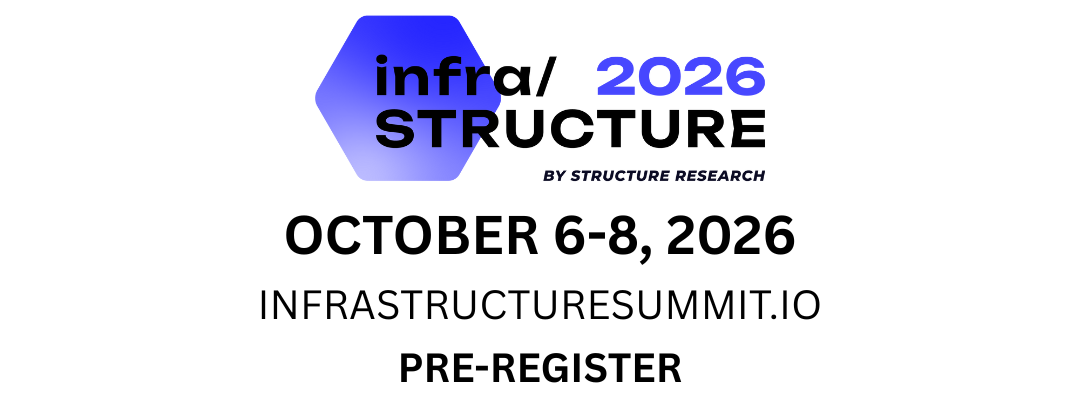WSS: CoreWeave acquires data centre capability, M&A activity picks up pace as hyperscale universe widens
The sector had a busy week highlighted by elevated activity in the M&A arena. CoreWeave acquired data centre operator Core Scientific in a deal valued at $9b, while investors made significant investments in hyperscale data centre operating platforms. We also continue to discuss the end of hyperscale colocation demand being limited to just a small group of companies. Two companies – Apple and Groq– are emerging as possibilities, with one of them much further along and actively building out infrastructure capacity and using colocation in the process. The week also saw strategic activity in Europe, while APAC saw more signs that Chinese hyperscale demand is shifting in a positive direction.
CoreWeave tried to acquire Core Scientific last year as it looked for a way to secure significant land and energy capacity while at the same time giving it more flexibility and control over its capital resources. That conversation probably never died and a year later an agreement was reached that will bring over 2GW into CoreWeave’s portfolio and help it realize capital and operating efficiencies. But the most significant implication of the acquisition is the impact it will have over the long-term on data centre colocation demand. CoreWeave has driven a substantial volume of colocation leasing activity of late as it does not have a self-building capability. The acquisition of Core Scientific gives it tools to make that shift and now all the leases with Core Scientific (about 500MW+ worth) are essentially self-builds. Is CoreWeave going to get into the business of data centre colocation or stick to self-building? Right now, given the level of demand, it is likely the latter, thought it will continue to lease capacity. This acquisition is more about bringing in capabilities, expertise and know-how, rather than new market entry.
There were other transactions of note in the past week as new investors took stakes in rapidly growing hyperscale data centre operating platforms. Avid data centre investor Stonepeak acquired a stake in Singapore-based Princeton Digital Group, while Allianz acquired an interest in Yondr. Meanwhile, French data centre operator Thesee Datacenter was acquired by infrastructure investor Vesper. The deals speak clearly to the ongoing interest in the space and the need for financial resources as operators continue to build out expansion capacity to serve accelerating hyperscale requirements. The growth of the sector and its healthy trajectory also continues to spawn new company formation and investment vehicles. BGO Datacenters entered the market recently and will target AI and hyperscale data centre investments in Europe. Again, all of these developments provide further evidence running counter to theories of an overbuild situation or data centre glut.
We have commented in recent weeks about the end of hyperscale. No, that does not mean hyperscale cloud is dead. Rather, the statement is meant to describe the end of hyperscale as it relates to the limited profile of hyperscale data centre colocation demand. Limited in the sense that only a very small group of companies are dominating the capacity leasing landscape. That has started to shift in recent years with the maturation of public cloud. Oracle Cloud is growing steadily and has rapidly ramped up its leasing, while the Chinese clouds have expanded globally in emerging markets and are driving demand there. Where the numbers have really moved, as mentioned above, is with the GPU clouds or neoclouds like CoreWeave. Oracle Cloud and CoreWeave have seen their growth propelled by the emergence of AI and this is set to create more multi-MW buyers. Other neoclouds are consuming colocation aggressively and new AI platforms like OpenAI are also moving the needle – either using colocation or driving colocation usage by using large quantities of hyperscale cloud infrastructure.
Another name to look for as the universe of hyperscale colocation demand widens is Apple. There has been some credible reporting that Apple has contemplated getting into the public cloud infrastructure game, with its internal chip development and user experience skills being key differentiators. Apple does consume data centre colocation, but a public cloud service would be a completely different animal. The possibility of an Apple or NVIDIA moving into public cloud infrastructure would be a game-changer and seems to be something on the horizon.
There are other signs that the demand profile for hyperscale colocation continues to see tailwinds. Alibaba Cloud confirmed data centre expansions in APAC and is investing more to support its service provider partner ecosystem. The Chinese clouds have come back from a sluggish period and are investing heavily in AI, which has translated into more data centre colocation leasing. With self-builds limited to China for this peer group, this is a huge positive for colocation demand in global markets where Chinese clouds operate.
or



